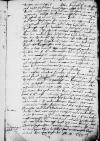Gestriges tages hab wir durch dissen E(wer) H(erlichkei)t boten(n) E(wer) H(erlichkei)t ⌊⌋ entfang(en), / ane die von ⌊Heilsberg⌋, / do von E(wer) H(erlichkei)t geschriben(n). / Solchs danksag(en) zcwisch(e)n frund(en) von weg(en) der pferde ist unnot, etc. Wir hetten E(wer) H(erlichkei)t neben den iren fast gern hie gesehen. / So sichs anders zugetrag(en), / muss die gedult das beste thun. / E(wer) H(erlichkei)t zukunfft uff die ⌊tagefart⌋, / so die aus solch(e)n ursachen, / wie E(wer) H(erlichkei)t schreibt, etwas vortzogen(n), / wolle wir bey den ⌊andren h(e)rn⌋ helffen ins beste deuten(n) etc. Vor die czeitung(en) thu wir uns fast bedanck(en) / un(n)d schicken disse beygebund(en), / wie wir sie habn(n) von(n) ⌊kay(serliche)r m(aieste)t⌋ ⌊botschaffter⌋ aus ⌊Hungern⌋ von ⌊Varadein⌋, den II tag Augusti vor negst vorgang(en) ⌊⌋. / Bitten die ⌊f(urstliche) d(urchlaucht)t⌋ neb(e)n unser(e)m ⌊⌋ zu bestellen(n), do mit eir f(urstliche) d(urchlaucht)t mag wissen mit was practik(e)n unser frunt ⌊Corneli(us)⌋, / was ⌊Dennemark(en)⌋ belangt, / ist umbgang(en), / hirum(m)b w written over ich⌈ichww written over ich⌉ir im zuschreiben(n), / so wir kein antwurt von im erlangt, / uns einzceit lang hab(e)n vorgenomen zuenthalden(n).
Kay(serliche)r ⌊botschaffter⌋ electus Lunden(sis) ist an konig ⌊Januss⌋ umb fried zu handlen geschickt, / uff bitt der II bischove ane(?) gedach(?)ter superinscribed⌈gedach(?)tergedach(?)ter superinscribed⌉ konig Janusen an ⌊kay(serlich)e m(aieste)t⌋ gen ⌊Naples⌋ heth geschikt. / Wirt aber, / wie er schreibt, ubel gehalden, / und richt nichts aus. / Die ⌊Hungern⌋ warten, wie dis spil mit den ⌊keiser⌋ sich wil enden(n) etc. Das ⌊f(urstliche) d(urchlauch)t⌋ uff ⌊Colmesze⌋ zceut, ist uns lieb. / Wirt vor gut nemen, was das haus hoth. / Wolt abermols ⌊f(urstliche) d(urchlauch)t⌋ gedenck(e)n von ⌊Rapten⌋, / das wir antwurt mocht(e)n haben / und des vihes unser ⌊svester⌋ und des molers, das gen ⌊Osterrode⌋ do von on the margin⌈do vondo von on the margin⌉ getrib(e)n, das wir wissen mugen, wie um(m)b alles etc. Ouch bit wir E(wer) H(erlichkei)t, wolt unser bey ⌊f(urstlicher) d(urchlauch)t⌋ im besten(n) nicht vorgessen(n) etc. Was sunst noch vil zu schreib(e)n wer, vorhalte wir uff unser zusamme komen(n), / das Got in in seiner gnad und on the margin⌈in seiner gnad undin seiner gnad und on the margin⌉ gesuntheit vorleye, / dem wir E(wer) H(erlichkei)t mit al den iren thun befel(e)n. /

 BCz, 244, p. 155
BCz, 244, p. 155